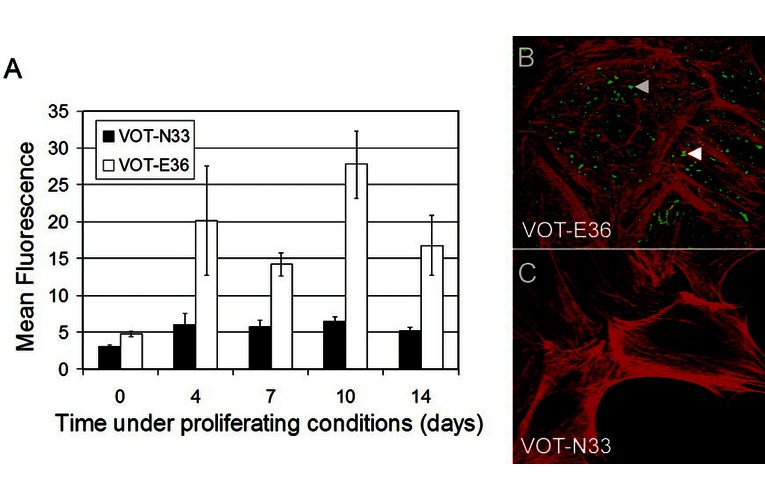Cat. #153626
US/VOT-N33 Cell Line
Cat. #: 153626
Sub-type: Continuous
Unit size: 1x10^6 cells / vial
Availability: 3-5 days
Organism: Mouse
Tissue: Embryonic
Disease: Deafness
Model: Transgenic
£575.00
This fee is applicable only for non-profit organisations. If you are a for-profit organisation or a researcher working on commercially-sponsored academic research, you will need to contact our licensing team for a commercial use license.
Contributor
Inventor: Matthew C Holley
Institute: University of Sheffield
Primary Citation: Lawoko-Kerali et al. 2004. Dev Dyn. 231(4):801-14. PMID: 15499550
Tool Details
*FOR RESEARCH USE ONLY
- Name: US/VOT-N33 Cell Line
- Alternate name: US/VOT-N33; Ventral Otocyst-Neuroblast cell line number 33; University of Sheffield/Ventral OTocyst-Neuroblast 33; VOT-N33
- Tool sub type: Continuous
- Organism: Mouse
- Tissue: Embryonic
- Disease: Deafness
- Morphology: Neuronal
- Growth properties: Adherent
- Model: Transgenic
- Model description: Conditionally immortalized cell line
- Crispr: No
- Conditional: Yes
- Conditional description: The cells were derived from ImmortomiceTM (Jat et al 1991 Proc. Nat. Acad. Sci. USA 88, 5096-5100) carrying a stable insertion of the conditional immortalising gene H-2Kb-tsA58, which describes a temperature-sensitive variant of the SV40 immortalising gene that encodes the large tumour antigen under the control of the ?interferon-sensitive MHC Class 1 promoter. The cells proliferating culturing conditions: 33°C with ?IFN; and the cells differentiating culturing conditions: 39...
- Description: US/VOT-N33 cells represent migrating neuroblasts. The conditionally immortal cell line was established from the ventral otocyst of the ImmortomouseTM at embryonic day 10.5 (plug in mouse designated E0.5 and birth at E18-19). At this stage the sensory epithelia have not differentiated, and the epithelium is competent to form most of the cells within the cochlear duct, including primary sensory neurons. US/VOT-N33 cell line has been characterised extensively by timed expression of inner ear neurons markers in conjunction with the transcription factor GATA3 under differentiating conditions in vitro. It has also been screened with Affymetrix mouse Micro-arrays. It forms exclusively bipolar neuronal phenotypes under differentiating conditions in vitro in the presence of FGFs and also following transplantation to the cochlear nerve in vivo
- Application: Inner ear development studies; Gene expression and function of inner ear-specific genes studies; In vitro screening for gene activation and promoter analysis; Ototoxicity (prescribed drugs and agents that ameliorate their affects) studies; Studies on function of inherited deafness mutations; Functional analysis of ion channels, receptors and signalling pathways in vitro"
- Production details: Homozygous male Immortomice (originally derived from injected oocytes of CBA/Ca x C57BL/10 mice) were time-mated with wild-type C57Bl/6 female mice to produce heterozygous offspring. Animals were killed by cervical dislocation, in accordance with UK Home Office regulations. Otocysts were removed from E10 embryos under sterile conditions and then dissected to isolate the ventral region. Further selection of ventral otocyst explants was based on expression of the immortalizing gene (condition...
- Biosafety level: 1
- Cellosaurus id: CVCL_VC37
Target Details
- Target: GATA3 (GATA Binding Protein 3)
- Target background: Zinc finger transcription factor
Applications
- Application: Inner ear development studies; Gene expression and function of inner ear-specific genes studies; In vitro screening for gene activation and promoter analysis; Ototoxicity (prescribed drugs and agents that ameliorate their affects) studies; Studies on function of inherited deafness mutations; Functional analysis of ion channels, receptors and signalling pathways in vitro"
Handling
- Format: Frozen
- Volume: 1 ml
- Growth medium: MEM with 10% FCS, 50Units/ml y-IFN, L-glutamine, 33?°C
- Temperature: 33° C
- Unit size: 1x10^6 cells / vial
- Shipping conditions: Dry ice
- Storage conditions: Liquid Nitrogen
- Mycoplasma free: Yes
- Characterisation tests: "Affymetrix mouse Micro-arrays; Proliferation (dependent upon the T-antigen); Morphology ; Tissue type (GATA3, Cytokeratin, ?4 integrins; ?3-tubulin, NeuroD, Pax-2, Myosin VI and VIIa expression tests)"
Related Tools
- Related tools: US/VOT-E36 Cell Line; GATA3eGFP reporter cell line; UB-UE1 Cell Line; UB-OC2 Cell Line; UB-OC1 Cell Line
References
- Sekiya et al. 2007. Eur J Neurosci. 25(8):2307-18. PMID: 17445229
- Lawoko-Kerali et al. 2004. Dev Dyn. 231(4):801-14. PMID: 15499550




